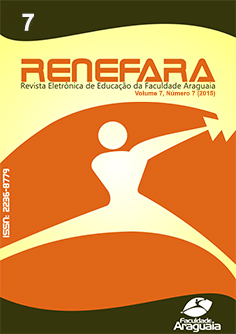LEVANTAMENTO ETNOBOTÂNICO DAS PLANTAS MEDICINAIS UTILIZADAS PELA POPULAÇÃO DO RESIDENCIAL GOIÂNIA VIVA, REGIÃO NOROESTE- GOIÂNIA, GOIÁS, BRASIL
Keywords:
Etnobotânica, Asteraceae, Lamiaceae, transmissão oralAbstract
Plantas medicinais são comumente utilizadas pelas populações desde a antiguidade, sendo esta uma prática transmitida de forma oral entre as gerações. O uso dessas plantas pelos seres humanos tem sido objeto de estudo de vários levantamentos etnobotânicos. Foi realizado um levantamento das plantas utilizadas como medicinais por moradores do bairro Residencial Goiânia Viva, região noroeste, Goiânia, Goiás, Brasil. As entrevistas, estruturadas, na forma de questionários semiestruturadas para obtenção dos dados sobre as plantas. A pesquisa resultou na descrição de 52 espécies, pertencentes a 22 famílias. As famílias com maior número de espécies foram Asteraceae e Lamiaceae. As partes das plantas mais utilizadas foram folhas e partes aéreas, sendo o chá a principal forma de utilização. Além disso, com os resultados obtidos e outras informações relevantes para uso consciente e seguro das plantas medicinais foi elaborada uma aula na versão virtual (CD). Esse CD foi distribuído para os professores de ciências e biologia dos Colégios estaduais e municipais do Bairro com intuito de fazer com que as informações sobre plantas medicinais retornem aos moradores do bairro por meio dos alunos que, em sua maioria, residem no bairro. A realização desse trabalho permitiu identificar a importância dos estudos em etnobotânica, pela necessidade de relatar o conhecimento tradicional que está sendo transformado conforme a sociedade se torna mais urbanizada.Downloads
Issue
Section
License
The copyright of the published articles will be transferred to the Uniaaraguaia Magazine, allowing its subsequent reproduction as transcription and with due citation of source. In the event of acceptance and before the publication of the article, the plaintiff (s) shall write a statement formally transferring copyright to the magazine.
The author may also print and distribute copies of his article, provided that he mentions that the rights belong to the Uniaaraguaia Magazine.
Author rights include the right to reproduce in full or partly by any means, distribute this article, including figures and photographs.
By submitting originals to the Uniaaraguaia magazine, the author or authors express agreement with the following terms:
a) Authors maintain copyright and grant Uniaraguaia magazine the right of first publication, with the work simultaneously licensed under the Creative Commons Attribution license that allows the sharing of work with recognition of the authorship and initial publication in this magazine.
b) Authors are authorized to assume additional contracts separately, for non-expiration distribution of the work version published in this magazine (eg publish in institutional repository or as book chapter), with recognition of authorship and initial publication in this journal.
c) Authors are allowed and are encouraged to publish and distribute their work online (eg in institutional repositories or on their personal page) to any point before or during the editorial process, as this can generate productive changes as well as increase the impact and citation of published work.

